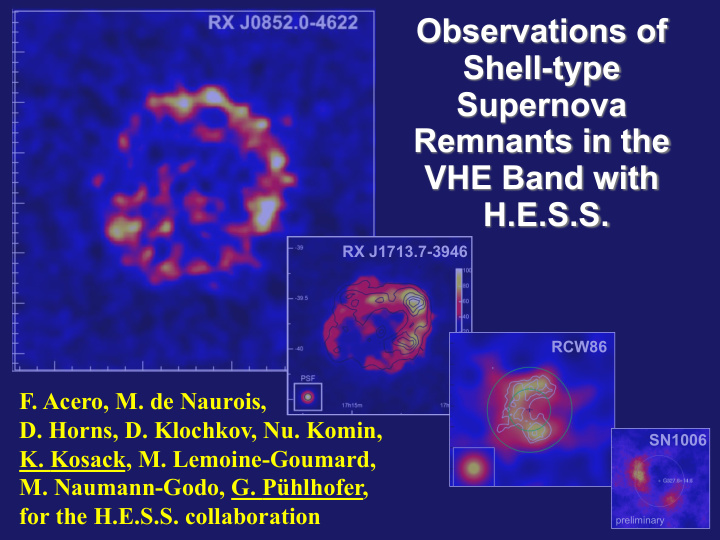



RX J1713.7-3946 RCW86 F. Acero, M. de Naurois, D. Horns, D. Klochkov, Nu. Komin, SN1006 K. Kosack, M. Lemoine-Goumard, M. Naumann-Godo, G. Pühlhofer, for the H.E.S.S. collaboration preliminary
H.E.S.S. 2004 RX J1713.7-3946 RX J1713.7-3946 Berezhko & Völk (2006) synchrotron o radiation decay Shock speed 1840 m/s e/p ~ 10 -4, B = 126 µ G asymptotically 50% H.E.S.S. 2005 Probable scenario: • Shock interacts with high density wind blown shell (probably inside molecular cloud) • Dominant leptonic VHE gamma-ray emission scenario would require low B-field (magnetic field damping after shock to explain X-ray synchrotron morphology ?) • Dominant hadronic VHE scenario fits nicely, but low level of thermal X-ray emission needs to be explained!
HESS VHE excess map XMM map (2-4.5 keV) B ? VHE -rays 2 – 4.5 keV X-rays smoothed X-ray contours SN 1006 preliminary Dist. 2.2 kpc Flux: 1% Crab H.E.S.S. prelim.
XMM map (2-4.5 keV) HESS VHE excess map smoothed to HESS PSF VHE -rays 2 – 4.5 keV X-rays smoothed X-ray contours preliminary Flux: 1% Crab H.E.S.S. prelim.
preliminary smoothed X-ray contours smoothed X-ray IC on o preliminary contours CMB decay • Mixed model (superposition of leptonic and hadronic VHE emission) Flux: 1% Crab gives good description of data, reasonable W p ~ 12% W SN H.E.S.S. prelim. • Pure leptonic model may also work (reasonable B-field of 45 µ G)
Chandra & XMM RCW 86 Age 2 kyr (?) Dist. 2.5 kpc (?) H.E.S.S . PSF • SNR expands in wind-blown bubble (cf. RX J1713.7-3946 + Vela Jr.), but: distinct regions of thermal (high ρ ) and non-thermal (low ρ ) X-rays • In NE , measured post-shock temperature (2.3±0.3 keV, from H α line width) is much smaller than expected (40..70 keV, from shock velocity measured with Chandra) (Helder et al., Science 2009) >50% of energy in non-thermal component or in turn, efficient CR acceleration “cools” thermal X-ray temperature • But: morphological comparisons not yet possible due to lack of VHE statistics
Galactic Plane, H.E.S.S., E>100 GeV
Galactic Plane, H.E.S.S., E>100 GeV There’s at least one !
HESS collaboration, A&A 2008: ~14 hours lifetime HESS J1731-347 Color map: H.E.S.S. γ -ray excess Contours: H.E.S.S. significance
HESS collaboration, A&A 2008: Tian et al., ApJ 2008 ~14 hours lifetime HESS J1731-347 B&W map: ATCA 1.4 GHz Color map: H.E.S.S. γ -ray excess Contours: H.E.S.S. significance
HESS collaboration, A&A 2008: HESS collaboration: ~14 hours lifetime ~30 hours lifetime HESS J1731-347 HESS J1731-347 Color map: H.E.S.S. γ -ray excess Shell model preferred at the 2.1 σ level Contours: H.E.S.S. significance more H.E.S.S. data under way
HESS J1731-347 All X-ray observations (Suzaku, XMM-Newton, Chandra) focused so far on the (X-ray-) bright Eastern part of the source Color map: XMM-Newton Technical details: MOS1+MOS2, 0.5-4.5 keV, 23 ksec Red contours: ATCA 1.4 GHz
HESS J1731-347 Color map: XMM-Newton Technical details: MOS1+MOS2, 0.5-4.5 keV, 23 ksec Red contours: ATCA 1.4 GHz Technical details: absorbed power-law spectra, MOS2 example spectrum from white dashed box region
HESS J1731-347 blue contours: XMM-Newton Significant gradient of absorption column N H = 1.0 .. 1.7 × 10 22 cm -2 x kpc ? Technical details: assumption of a pure power law, „wabs“ absorption model opens up possibility for SNR a distance estimate!
HESS J1731-347 blue contours: XMM-Newton blue contours: XMM-Newton [N H ] = 10 22 cm -2 Matching increase in absorption Significant gradient of absorption derived from 12 CO observations Technical details: CfA CO survey data; map column N H = 1.0 .. 1.7 × 10 22 cm -2 integrated from LSR velocities between 0 and -17 Technical details: assumption of a pure power law, kms -1 , where first peak towards the SNR appears; „wabs“ absorption model CO-to-H 2 mass conversion factor 2.5 × 10 20 cm -2 K -1 km -1 s Object is at least 3.5 kpc away! Technical details: Galactic rotation model from Fich et al. 1989
• The class of VHE-emitting SNR shells is slowly growing; latest addition is SN 1006 • Hadronic vs. leptonic VHE emission scenarios (so far) usually employ spectral and morphological comparisons to X-ray emission • HESS J1731-347: If association of VHE emission with the SNR (radio) shell will be confirmed, then HESS J1731-347 is the most distant spatially resolved VHE SNR shell detected so far • With the same caveat, HESS J1731-347 could be the oldest yet identified shell-type VHE SNR; from a simple Sedov solution: 1 2 years (if E 10 51 erg) n 0 t SNR 4800 0.1 cm 3
Recommend
More recommend